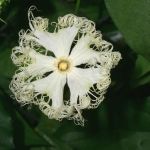| Common Name: |
Snake Gourd |
| Other Names: |
Chinese Cucumber |
| Botanical Name: |
Trichosanthes kirilowii syn. Eopepon vitifolius |
| Genus: |
Trichosanthes |
| Family: |
Cucurbitaceae |
| Native Location: |
Mongolia, China, and Vietnam |
| Cultivation: |
Moist, well-drained soil in partial shade. Thin out overcrowded branches to allow air to circulate around developing fruits. Prone to attack by spider mites and whiteflies when grown in a greenhouse. |
| Propagation: |
By seed sown at 20°C (68°F) in spring, soaked for 24 hours before sowing; by softwood cuttings in summer. |
| Harvest: |
Tubers and fruits are harvested in autumn and dried for use in decoctions, pills, and powders. |
| Height: |
6-9m (20-28ft) |
| Hardiness: |
Z7-9 |
| Parts Used: |
Tubers (gua lou gen, tian hua fen), fruit peel (gua lou pi), seeds (gua lou zi). |
| Properties: |
A bitter-sweet, anti-inflammatory, cooling herb that lowers fever, promotes secretions (notably lactation), and stimulates the uterus (tubers). A sweet, expectorant, laxative herb that stimulates the circulation, dilates the bronchial vessels, moistens dry tissues, and is anti-bacterial and anti-fungal (fruits). |
| Medicinal Uses: |
Internally for diabetes, dry coughs, abscesses, childbirth (second stage of labor), and abortion (tubers); bronchial infections with thick phlegm, chest pain and tightness, dry constipation, and lung and breast tumors (fruits). Fruits are traditionally prepared as a winter soup to ward off colds and influenza. |
| Warning: |
Contraindicated during pregnancy |
| Bibliography: |
Encyclopedia of Herbs by Deni Brown Copyright © 1995, 2001 Dorling Kindersley Limited Pg 392 |

